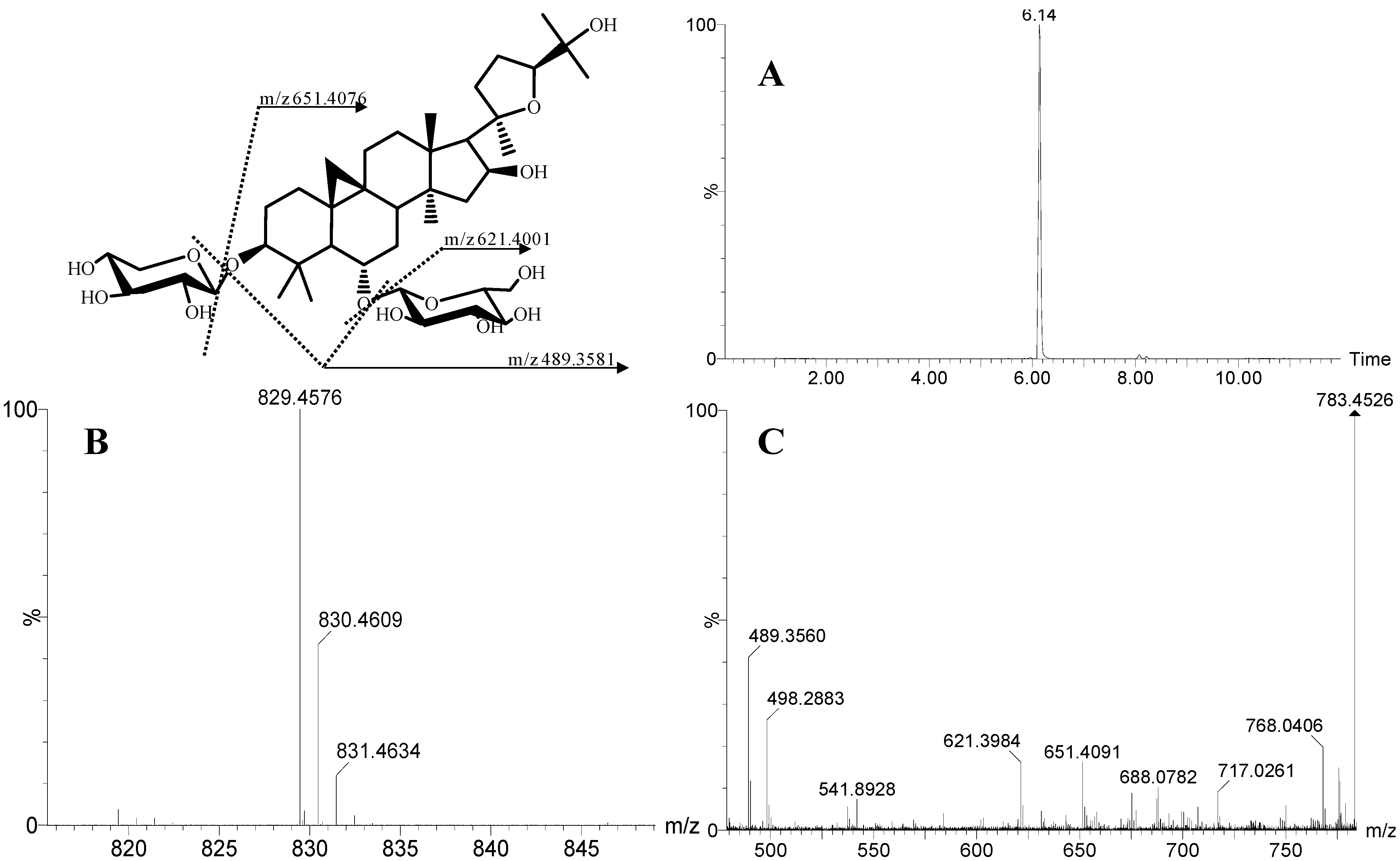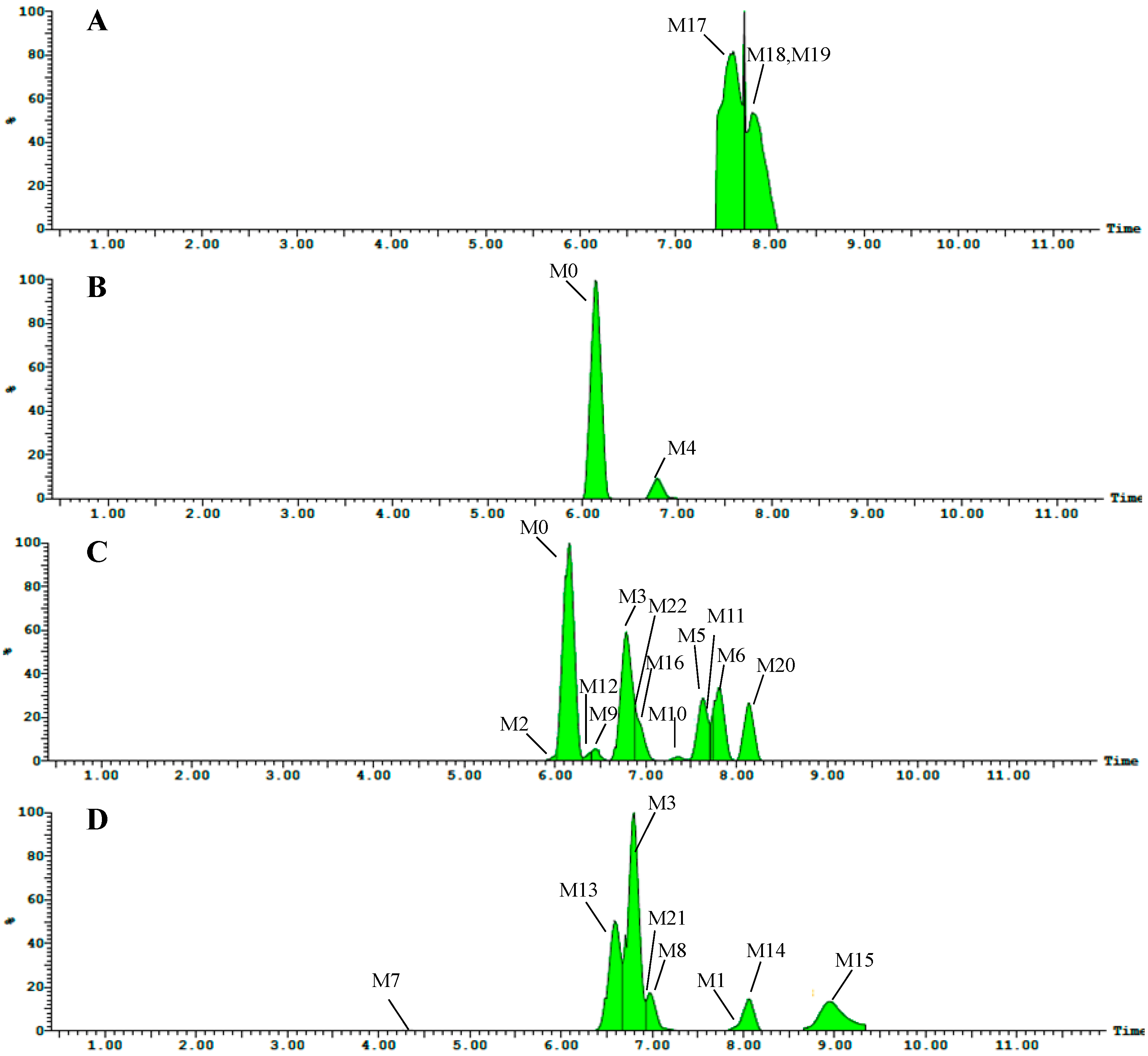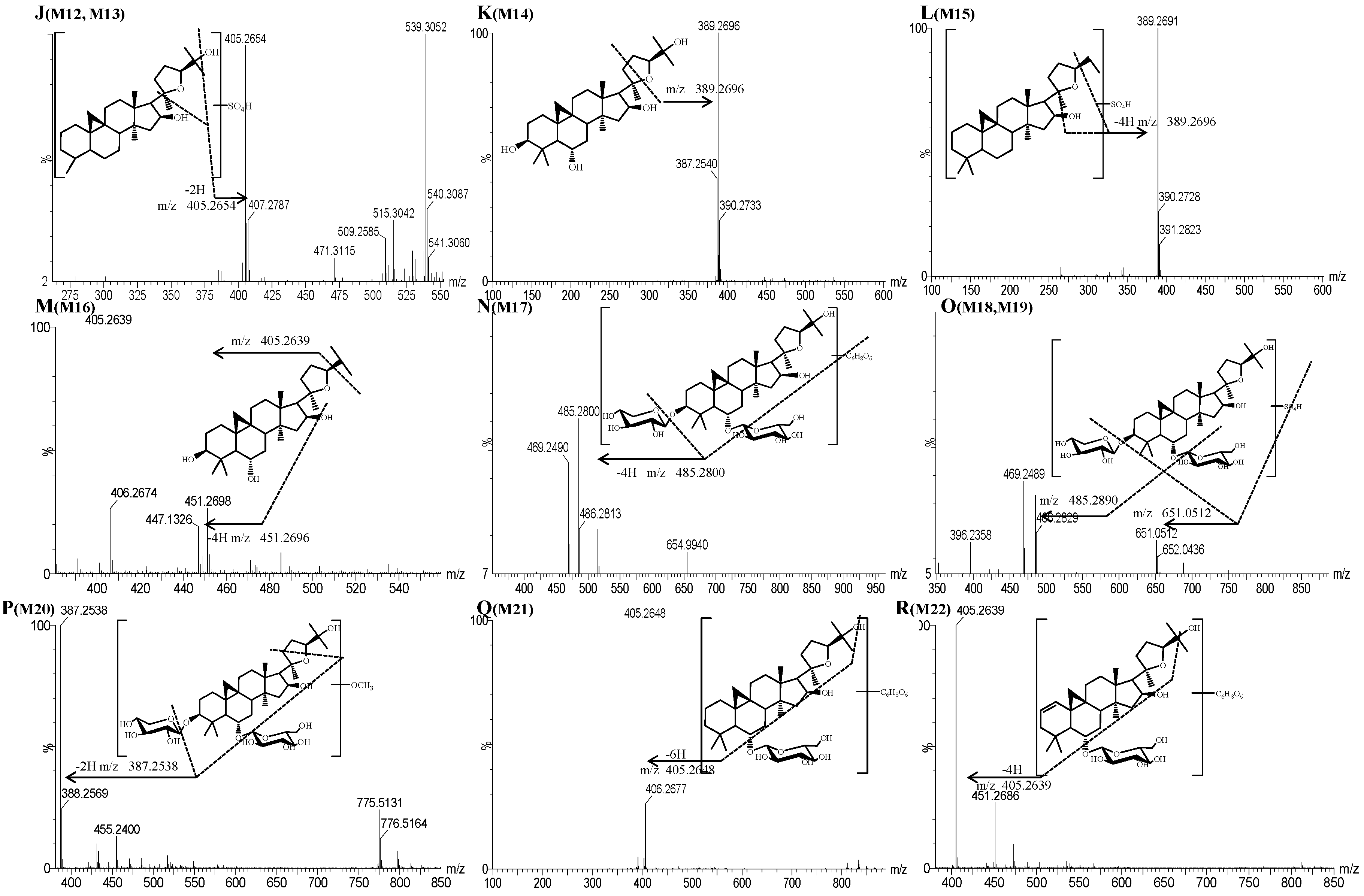Profiling the Metabolism of Astragaloside IV by Ultra Performance Liquid Chromatography Coupled with Quadrupole/Time-of-Flight Mass Spectrometry
Abstract
:1. Introduction
2. Results and Discussion
2.1. Chromatographic and MS Characterization of Astragaloside IV

2.2. Metabolite Profiling



2.3. Identification of Metabolites
2.3.1. Metabolite M1
2.3.2. Metabolites M2 and M3
| No. | Ion mode | Formula | tR(min) | Calculated(m/z) | Measured(m/z) | ppmerror | Fragments(m/z) | Metabolic Description | Metabolites Found | |||
|---|---|---|---|---|---|---|---|---|---|---|---|---|
| Plasma | Bile | Urine | Feces | |||||||||
| M0 | [M+HCOOH−H]− | C42H70O16 | 6.14 | 829.4586 | 829.4562 | −2.9 | 621, 489 | Parent | No | Yes | Yes | No |
| M1 | [M−H]− | C41H64O14 | 7.98 | 779.4218 | 779.4278 | 7.7 | 389.2690 | dehydrogenation | No | No | No | Yes |
| M2 | [M+HCOOH−H]− | C37H62O12 | 6.00 | 697.4163 | 697.4193 | 4.3 | 471.2417, 359.1884, 347.2222 | Deglycosylation | No | No | Yes | No |
| M3 | [M+HCOOH−H]− | C37H62O12 | 6.77 | 697.4163 | 697.4145 | −2.6 | 471.2417, 359.1884, 347.2222 | Deglycosylation | No | No | Yes | Yes |
| M4 | [M+HCOOH−H]− | C36H60O11 | 6.78 | 667.4058 | 667.4044 | −2 | 515.3008 | Deglycosylation | No | Yes | No | No |
| M5 | [M−H]− | C37H62O10 | 7.62 | 665.4265 | 665.4269 | 0.6 | 485.2821 | Glucuronide + deglycosylation | No | No | Yes | No |
| M6 | [M−H]− | C37H62O10 | 7.8 | 665.4265 | 665.4237 | −4.2 | 485.2817 | Glucuronide + deglycosylation | No | No | Yes | No |
| M7 | [M−H]− | C36H56O11 | 4.32 | 663.3745 | 663.3753 | 1.3 | 615.2835, 599.2897, 583.2925, 429.1947 | Glucuronide + deglycosylation | No | No | No | Yes |
| M8 | [M+HCOOH−H]− | C36H60O10 | 6.96 | 651.4108 | 651.4109 | 0.1 | 553.3184, 523.3073, 405.2650, 391.2852 | Deglycosylation + dehydroxylation | No | No | No | Yes |
| M9 | [M−H]− | C36H60O8 | 6.43 | 619.421 | 619.4197 | −2.1 | 453.2858, 407.2801 | Deglycosylation + dehydrogenation | No | No | Yes | No |
| M10 | [M−H]− | C30H50O8S | 7.34 | 569.3148 | 569.3162 | 2.4 | 551.2433, 519.2256,485.2810, 457.2569 | Deglycosylation + sulfation | No | No | Yes | No |
| M11 | [M−H]− | C30H50O7S | 7.74 | 553.3199 | 553.3212 | 2.3 | 515.0021, 485.2805 | Deglycosylation + sulfation | No | No | Yes | No |
| M12 | [M−H]− | C29H48O7S | 6.4 | 539.3043 | 539.3059 | 3 | 475.2653, 453.2846, 407.2786, 405.2641 | Deglycosylation + sulfation+ demethylation | No | No | Yes | No |
| M13 | [M−H]− | C29H48O7S | 6.58 | 539.3043 | 539.3036 | −1.2 | 515.3042, 509.2585, 471.3115, 405.2654 | Deglycosylation + sulfation + demethylation | No | No | No | Yes |
| M14 | [M+HCOOH−H]− | C31H52O7 | 8.05 | 535.3635 | 535.364 | 0.9 | 389.2696 | Deglycosylation | No | No | No | Yes |
| M15 | [M−H]− | C29H48O6S | 8.93 | 523.3094 | 523.3094 | 0.1 | 389.2691 | Deglycosylation + sulfation + demethylation + deoxygenation | No | No | No | Yes |
| M16 | [M−H]− | C29H46O5 | 6.89 | 473.3267 | 473.3263 | −0.9 | 451.2698, 447.1326, 405.2639 | Deglycosylation + deoxygenation | No | No | Yes | No |
| M17 | [M−H]− | C46H76O20 | 7.91 | 959.4852 | 959.487 | 1.9 | 485.2800, 469.2490 | Glucuronidation | Yes | No | No | No |
| M18 | [M−H]− | C42H72O17S | 7.62 | 879.4412 | 879.4387 | −2.9 | 651.0512, 469.2489 | Sulfateconjugation | Yes | No | No | No |
| M19 | [M−H]− | C42H72O17S | 7.81 | 879.4412 | 879.4373 | −3.9 | 651.0512, 469.2489 | Sulfateconjugation | Yes | No | No | No |
| M20 | [M−H]− | C42H70O15 | 8.14 | 813.4637 | 813.4667 | 3.7 | 775.5131, 455.2400, 387.2538 | Methoxylation | No | No | Yes | No |
| M21 | [M−H]− | C41H64O16 | 6.92 | 811.4116 | 811.4180 | 7.8 | 405.2648 | Glucuronide + deglycosylation | No | No | No | Yes |
| M22 | [M−H]− | C42H66O15 | 6.86 | 809.4324 | 809.4262 | −7.6 | 451.2686, 405.2628 | Glucuronide + deglycosylation + dehydrogenation | No | No | Yes | No |

2.3.3. Metabolite M4
2.3.4. Metabolites M5 and M6
2.3.5. Metabolite M7
2.3.6. Metabolite M8
2.3.7. Metabolite M9
2.3.8. Metabolite M10
2.3.9. Metabolite M11
2.3.10. Metabolites M12 and M13
2.3.11. Metabolite M14
2.3.12. Metabolite M15
2.3.13. Metabolite M16
2.3.14. Metabolite M17
2.3.15. Metabolites M18 and M19
2.3.16. Metabolite M20
2.3.17. Metabolite M21
2.3.18. Metabolite M22
2.4. Discussion
3. Experimental Section
3.1. Chemicals and Reagents
3.2. Animal Protocol
3.2.1 Plasma Sampling
3.2.2. Bile Sampling
3.2.3. Sampling of Urine and Feces
3.3. Sample Preparation
3.3.1. Plasma
3.3.2. Bile
3.3.3. Urine
3.3.4. Feces
3.4. Instrumentation and Conditions
3.5. Data Analyses
4. Conclusions
Acknowledgements
Author Contributions
Conflicts of Interest
References
- Bu, W.; Akama, T.; Chanda, S.; Sullivan, D.; Ciaravino, V.; Jarnagin, K.; Freund, Y.; Sanders, V.; Chen, C.W.; Fan, X.; et al. Early rapid identification of in vivo rat metabolites of AN6414, a novel boron-containing PDE4 inhibitor by QTRAP LC/MS/MS to support drug discovery. J. Pharm. Biomed. Anal. 2012, 70, 344–353. [Google Scholar] [CrossRef]
- Kumar, V.; Schuck, E.L.; Pelletier, R.D.; Farah, N.; Condon, K.B.; Ye, M.; Rowbottom, C.; King, B.M.; Zhang, Z.Y.; Saxton, P.L.; et al. Pharmacokinetic characterization of a natural product-inspired novel MEK1 inhibitor E6201 in preclinical species. Cancer Chemother. Pharm. 2012, 69, 229–237. [Google Scholar] [CrossRef]
- Hong, Z.; Zhao, L.; Wang, X.; Le, J.; Jia, J.; Chai, Y.; Zhang, G. High-performance liquid chromatography-time-of-flight mass spectrometry with adjustment of fragmentor voltages for rapid identification of alkaloids in rat plasma after oral administration of rhizoma Corydalis extracts. J. Sep. Sci. 2012, 35, 1690–1696. [Google Scholar] [CrossRef] [PubMed]
- Zhao, Y.Y.; Su, Q.; Cheng, X.L.; Tan, X.J.; Bai, X.; Lin, R.C. Pharmacokinetics, bioavailability and metabolism of rhaponticin in rat plasma by UHPLC-Q-TOF/MS and UHPLC DaD-MSn. Bioanalysis 2012, 4, 713–723. [Google Scholar] [CrossRef] [PubMed]
- Editorial Committee of Chinese Pharmacopeia. Pharmacopeia of the People’s Republic of China, Sec. A; Chemical Industry Press, Inc.: Beijing, China, 2010; pp. 283–284. [Google Scholar]
- Luo, Y.; Qin, Z.; Hong, Z.; Zhang, X.; Ding, D.; Fu, J.H.; Zhang, W.D.; Chen, J. Astragaloside IV protects against ischemic brain injury in a murine model of transient focal ischemia. Neurosci. Lett. 2004, 363, 218–223. [Google Scholar] [CrossRef]
- Wang, B.; Chen, M.Z. Astragaloside IV possesses antiarthritic effect by preventing interleukin 1β-induced joint inflammation and cartilage damage. Arch. Pharm. Res. 2014, 37, 793–802. [Google Scholar] [CrossRef] [PubMed]
- Gui, D.; Huang, J.; Liu, W.; Guo, Y.; Xiao, W.; Wang, N. Astragaloside IV prevents acute kidney injury in two rodent models by inhibiting oxidative stress and apoptosis pathways. Apoptosis 2013, 18, 409–422. [Google Scholar] [CrossRef] [PubMed]
- Chen, X.; Peng, L.H.; Li, N.; Li, Q.M.; Li, P.; Fung, K.P.; Leung, P.C.; Gao, J.Q. The healing and anti-scar effects of astragaloside IV on the wound repair in vitro and in vivo. J. Ethnopharmacol. 2012, 139, 721–727. [Google Scholar] [CrossRef] [PubMed]
- Huang, L.F.; Yao, Y.M.; Li, J.F.; Zhang, S.W.; Li, W.X.; Dong, N.; Dong, N.; Yu, Y.; Sheng, Z.Y. The effect of Astragaloside IV on immune function of regulatory T cell mediated by high mobility group box 1 protein in vitro. Fitoterapia 2012, 83, 1514–1522. [Google Scholar] [CrossRef]
- Zhang, W.D.; Zhang, C.; Liu, R.H.; Li, H.L.; Zhang, J.T.; Mao, C.; Moran, S.; Chen, C.L. Preclinical pharmacokinetics and tissue distribution of a natural cardioprotective agent astragaloside IV in rats and dogs. Life Sci. 2006, 79, 808–815. [Google Scholar] [CrossRef]
- Du, Y.; Zhang, Q.; Chen, G.G.; Wei, P.; Tu, C.Y. Pharmacokinetics of astragaloside IV in rats by liquid chromatography coupled with tandem mass spectrometry. Eur. J Drug Metab. Pharm. 2005, 30, 269–273. [Google Scholar] [CrossRef]
- Yan, L.X.; Guo, D.A. Quantitation of astragaloside IV in rat plasma by liquid chromatography-tandem mass spectrometry. J. Chromatogr. B 2005, 824, 244–248. [Google Scholar] [CrossRef]
- Huang, C.R.; Wang, G.J.; Wu, X.L.; Li, H.; Xie, H.T.; Lv, H.; Sun, J.G. Absorption enhancement study of astragaloside IV based on its transport mechanism in caco-2 cells. Eur. J. Drug Metab. Pharm. 2006, 31, 5–10. [Google Scholar]
- Li, C.Y.; Qi, L.W.; Li, P. Correlative analysis of metabolite profiling of Danggui Buxue Tang in rat biological fluids by rapid resolution LC-TOF/MS. J. Pharm. Biomed. Anal. 2011, 55, 146–160. [Google Scholar] [CrossRef] [PubMed]
- Wen, X.D.; Liu, E.H.; Yang, J.; Li, C.Y.; Gao, W.; Qi, L.W.; Wang, C.S.; Yuan, C.S.; Li, P. Identification of metabolites of Buyang Huanwu decoction in rat urine using liquid chromatography-quadrupole time-of-flight mass spectrometry. J. Pharm. Biomed. Anal. 2012, 67–68, 114–122. [Google Scholar] [CrossRef] [PubMed]
- Gao, S.; Basu, S.; Yang, Z.; Deb, A.; Hu, M. Bioavailability challenges associated with development of saponins as therapeutic and chemopreventive agents. Curr. Drug Targets 2012, 13, 1885–1899. [Google Scholar] [CrossRef] [PubMed]
- Yu, K.; Chen, F.; Li, C. Absorption, disposition, and pharmacokinetics of saponins from Chinese medicinal herbs: what do we know and what do we need to know more? Curr. Drug Metab. 2012, 13, 577–598. [Google Scholar] [CrossRef]
- Ruan, J.Q.; Leong, W.I.; Yan, R.; Wang, Y.T. Characterization of metabolism and in vitro permeability study of notoginsenoside R1 from Radix notoginseng. J. Agric. Food Chem. 2010, 58, 5770–5776. [Google Scholar] [CrossRef] [PubMed]
- Sample Availability: Samples of the compounds astragaloside IV are not available.
© 2014 by the authors. Licensee MDPI, Basel, Switzerland. This article is an open access article distributed under the terms and conditions of the Creative Commons Attribution license ( http://creativecommons.org/licenses/by/4.0/).
Share and Cite
Cheng, X.-D.; Wei, M.-G. Profiling the Metabolism of Astragaloside IV by Ultra Performance Liquid Chromatography Coupled with Quadrupole/Time-of-Flight Mass Spectrometry. Molecules 2014, 19, 18881-18896. https://doi.org/10.3390/molecules191118881
Cheng X-D, Wei M-G. Profiling the Metabolism of Astragaloside IV by Ultra Performance Liquid Chromatography Coupled with Quadrupole/Time-of-Flight Mass Spectrometry. Molecules. 2014; 19(11):18881-18896. https://doi.org/10.3390/molecules191118881
Chicago/Turabian StyleCheng, Xu-Dong, and Ming-Gang Wei. 2014. "Profiling the Metabolism of Astragaloside IV by Ultra Performance Liquid Chromatography Coupled with Quadrupole/Time-of-Flight Mass Spectrometry" Molecules 19, no. 11: 18881-18896. https://doi.org/10.3390/molecules191118881




